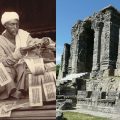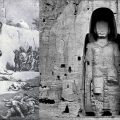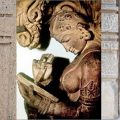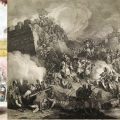Historicity of Sambhal; ASI Findings Debunking False Narratives

A clearer understanding of when the current Shahi Jama Masjid in Sambhal was built can be developed by studying the two timelines that together tell the site’s history comprehensively.
While a Bench consisting of Chief Justice Sanjiv Khanna and Justice Sanjay Kumar reviews a petition submitted by the Jama Mosque Committee challenging a civil court’s order that permitted a survey of the mosque to ascertain if it was constructed on the remnants of a temple, and violence erupted on November 24 during the survey in Sambhal, resulting in the deaths of four individuals and injuries to numerous others, including police personnel, a review of the history of the heritage site will be in order.
In 1879 CE, a significant survey report prepared by archaeologist Archibald Campbell Carlleyle for Major General Alexander Cunningham reached the British Army headquarters in British India. It states: “The principal building in Sambhal is the Jami Masjid, which the Hindus claim was originally the temple of Hari Mandir.”
This claim has become central to the legal dispute between the Shahi Jama Masjid and the Harihar Mandir, highlighting its historical importance.
What specific evidence did Archibald Campbell Carlleyle use to support the claim about the Jami Masjid’s origins? What are the historical traces of the conflict between the Shahi Jama Masjid and the Harihar Mandir? How the historical significance of the ASI reports and the chronology of events influenced contemporary views on religious sites in the region and the exact timeline of Sambhal follow.
Origin of Sambhal and tale of two timelines
Sambhal is a historically important Uttar Pradesh city founded by Emperor Yayati, as noted in the Matsya Purana. Senior historian Dr Ajay Anupam highlights the significance of the Harihar Temple there, referenced in the Shrimad Bhagwat Purana, Skanda Purana, and Matsya Purana. He asserts that the temple’s origins date back at least 5,000 years and that the Shrimad Bhagwat Purana details its establishment, emphasizing its historical and religious importance.
The name “Sambhal” is referenced in Carlleyle’s 1879 Archaeological Survey of India report as Sambhaleshwar in the Satya Yuga, Mahadgiri in the Treta Yuga, and Pingala in the Dwapar Yuga. Carlleyle recognized its historical significance in Hindu texts, underscoring its importance over time.
During Mauryan rule, Pingala was renamed Sambhalgram, later shortened to Sambhal. In the 5th century BCE, it was part of the Panchal state, which was included in Emperor Ashoka’s empire. The Panchal state is also mentioned in the Mahabharata, again highlighting Sambhal’s historical significance.
During the rule of the Chauhan Rajputs in northern India, Emperor Prithviraj Chauhan governed Sambhal. A significant event in Sambhal’s history, noted in Carlleyle’s ASI survey report, occurred during this time. We will discuss this event later in this section.
After the Second Battle of Tarain in 1192 CE, Mohammad Shahabuddin Ghori took control of Sambhal, followed by his slave Qutubuddin Aibak. This period was marked by continuous attacks, especially during Sultan Balban’s reign.
In the 14th century, Sambhal city faced its first proper siege under Sultan Firoz Shah Tughlaq, who eliminated several small Hindu rulers and established direct Muslim control from Delhi. In the late 15th century, Sikandar Lodhi ruled Sambhal for four years and made it the capital of his empire.
Sambhal’s historical importance is underscored by the First Battle of Panipat in 1528 CE, a pivotal event that fundamentally reshaped India’s course. This battle marked the arrival of Babur, the first Mughal invader, and decisively transformed Sambhal’s narrative. This is the second critical event in Sambhal’s history.
Findings of ASI and debunking of fake narratives
Having explored two timelines, it’s time to pinpoint their twists. The first timeline we analyze is that of Prithviraj Chauhan, featuring three key accounts related to Harihar Mandir, or Hari Mandir.
Carlleyle ‘s ASI report from 1879 clearly states that under Prithviraj Chauhan, a temple named Hari Mandir was rebuilt. This Vishnu temple was dedicated to the Kalki avatar. Since it was rebuilt by the Chauhan dynasty, it indicates its existence before Chauhan’s reign.
Also, we have already seen the critical importance of the temple built by Emperor Yayati and Harihar, supported by historical accounts. So, it again confirms the existence of the Harihar temple before the Prithviraj era.
The 1891 ASI report by A. Fuiirer highlights Prithviraj Chauhan’s key role in the rebuilding of Hari Mandir, a fact further confirmed by the 1911 Moradabad gazetteer by H.R. Nevil.
Western historians tend to prioritize European narratives, often overlooking Prithviraj Chauhan’s crucial role in rebuilding Hari Mandir in Sambhal.
2nd timeline
Now the second timeline of the Mughal invader Babur, as documented in Carlleyle’s report. Carlleyle discovered an inscription at the Shahi Jama Masjid stating that Babur’s commander, Mir Hindu Beg, built the mosque — a claim validated by local scholars.
However, Carlleyle noted a significant error: Babur’s name is incorrectly recorded as “Shah Jamjah Muhammad Babar,” instead of “Shah Zahiruddin Muhammad Babur,” although Mir Hindu Beg’s contribution is accurately acknowledged. Carlleyle directly engaged with local Muslim scholars, who confirmed that the inscription was indeed a forgery. Meanwhile, Hindus insisted that this inscription had been backdated in the mosque.
Carlleyle stated that after 1857 CE, control of the monument rightfully shifted to the local Muslims, who effectively utilized the forged inscription to win a civil court case against Hindus regarding possession of the site.
Nevertheless, the question remains: How was the Shahi Jama Masjid converted from a Hindu temple, and what conclusion did Carlleyle reach?
Carlleyle noted significant architectural flaws in the Shahi Jama Masjid during his inspection. He observed that the dome is designed on both an octagonal and square base. He found that the walls, originally made of red limestone, were later covered with mismatched plaster. Carlyle noted that while the original stones in the courtyard were replaced with smaller bricks, some older stones remain. He noted that the original square-based temple had a single 8-foot-wide doorway facing east, while the new masjid features four 6-foot-wide doorways cut from the original stone door.
Most ancient Hindu temples were constructed from stones, typically with a square base & a single eastern-facing doorway.
Both the 1891 ASI report and the 1911 Moradabad gazetteer reports conclude the exact continuation of Carlleyle ‘s 1879 ASI report.
This conclusively shows that the Shahi Jama Masjid was not built by Babur, debunking the narrative of the Shahi Jama Masjid Prabandhan committee, which many Muslims still accept as truth.
Sambhal’s religious importance
In the early 14th century, China was under the rule of the last Mongol dynasty. During this period, the Chinese Mongol Empire sent an official ambassador to the Sultan of Delhi, Muhammad bin Tughlaq.
The ambassador was dispatched with a request for permission to rebuild a temple in Sambhal. However, a question arises: which temple was to be rebuilt?
Before addressing the question, it’s important to note that both ancient Tibetan and Hindu beliefs regard Shambhala, or Sambhal, as the birthplace of Lord Vishnu’s future avatar, the Kalki Avatar. Tibetan texts typically place Shambhala in Tibet or Mongolia, while Hindu texts refer to it as modern-day Sambhal. In both traditions, the religious significance of Shambhala/Sambhal is profound.
Sambhal is undeniably a site of substantial religious importance, firmly establishing its connection to the influential Chinese Mongol Empire. Recognizing this relationship is essential for appreciating Sambhal’s vital role in the intricate narrative of Asian history.
Now, returning to the story, the official request from the Chinese Mongol Empire was denied by Mohammad bin Tughlaq. Here, we again encounter the term “rebuilt,” which indicates the ghastly condition of the ancient Harihar Mandir during that period.
Ibn Battuta, a renowned traveller of medieval times, recorded this account during the rule of Mohammad bin Tughlaq at the royal court.
Here are two important questions to address:
1. Who was responsible for the destruction of the ancient Harihar Temple?
2. Who constructed the current Shahi Jama Masjid in Sambhal? We will discuss the answers in chronological order.
Who destroyed ancient Harihar Temple?
To find the specific answer, we need to analyze various historical timelines. During the late 13th century, Sultan Balban ruled India and, in 1254 CE, he launched a brutal attack on Sambhal to suppress a local Hindu uprising. This onslaught nearly wiped out the Hindu population there.
This event is detailed in the “Tarik-i-Firozshahi” and referenced in Brijendra Mohan Sankhder’s book, “Sambhal: A Historical Survey,” specifically in the section titled “Balban’s Ruthless Massacre at Sambhal.”
As a result of this devastation, the chances of the ancient Harihar temple surviving until the time of Babur, two centuries later, are very slim.
During the reign of Sultan Sikandar Lodhi, in the 15th century, Sambhal served as the capital of his empire for four years. As a staunch Muslim imperialist, Sikandar Lodhi established various Islamic educational centres in Sambhal, which significantly diminished the survival of the ancient Harihar temple.
Even Babur’s grandson Akbar’s court historian Abul Fazl’s book “Ain-i Akbari” has a strong reference to the ancient Harihar temple in Sambhal. Ain-i-Akbari, page 281, quotes:
In the city of Sambhal, there is a temple of “Harimandal”, the temple of Vishnu, belonging to a Brahmin, from whose descendants, the 10th Avatar will appear in this spot.
However, this quote doesn’t mention the condition of the temple in that era, such as whether it was functional or in ruins.
Interestingly, the current Shahi Jama Masjid in Sambhal is not mentioned in the Ain-i-Akbari. This implies that until the era of Akbar, the Shahi Jama Masjid likely did not exist. It can thus be concluded that the ancient Harihar temple was destroyed between the rule of Balban and that of Sikandar Lodhi.
Who built Sambhal Shahi Jama Masjid?
To understand this answer, we must first examine the demographic changes in Sambhal. The region, historically part of the Panchal state, is located in the heart of Rohilkhand. It is important to note that the term “Rohilkhand” did not come into existence until the time of Mughal Emperor Aurangzeb.
In the late 17th century, around 1670 CE, Aurangzeb decided to compile a book that would serve as a comprehensive guide to Sharia-based codes of conduct for Indian Muslims. This book, called “Fatawa-e-Alamgiri”, encompasses various aspects such as statecraft, general ethics, military strategy, economic policy, justice, and punishment. It is now considered one of the greatest compilations of Muslim law during Mughal India. Subsequently, it became the reference legal text for enforcing sharia in colonial South Asia from the 18th century through the early 20th century.
To compile Fatawa-e-Alamgiri, emperor Aurangzeb gathered 500 experts in Islamic jurisprudence, 300 from the entire Indian subcontinent (India, Pakistan, Bangladesh & Myanmar) 100 from Iraq and 100 from the Hejaz (Saudi Arabia). So, during this very time, the migration of certain tribes happened from central Asia to India, as all these scholars were accompanied by their local servants.
There was a tribe originally from the Kandahar region, which is located in present-day Afghanistan. This tribe gradually migrated towards the current Afghanistan-Pakistan border, known as the Durand Line, due to continuous waves of invasions from Central Asia into India.
This particular tribe was called “Rohillas”.This term “Rohilla” originated from “Roh”, meaning the hilly country, where Rohilla was used as a fairly broad notion of the people from Roh. Later Roh referred to a geographical term which corresponded with, in its limited sense, the territory stretching from Swat and Bajaur in the north to Sibi in the south, and from Hasan Abdal (Attock) in the east to Kabul and Kandahar in the west, which corresponded with the homeland of the Pashtuns.
This migration increased significantly during the time of Nader Shah’s attack(1739 CE), and the migrants eventually settled in the towns of Saharanpur, Rampur, Pilibhit, Badaun, and Bareilly. All of this occurred within a brief 40-year period, spanning from the end of Aurangzeb’s era to the arrival of Nader Shah.
During the period when the Marathas were trying to expand their influence in northern India, the Rohillas emerged as a dominant force in the region of Panchal, which is now part of western Uttar Pradesh. Sambhal became the central focal point during the era of the Rohillas.
The Rohillas were instrumental in inviting Ahmad Shah Abdali, the founder of Afghanistan, to invade India, much like his predecessor Nader Shah, who had been Abdali’s original master. This resulted in the Third Battle of Panipat, which took place in 1761 CE. The Third Battle of Panipat was a pivotal moment in history, fundamentally reshaping the trajectory of modern India.
Before this fierce battle, Abdali was invited in 1757 CE also, which led to the devastation of Mathura, Gokul, Bulandshahr, and Vrindavan. This attack was orchestrated by the Rohillas and executed by Abdali. The Third Battle of Panipat was a response by the Marathas to this invasion by the Afghans.
In 1772 CE, after the Marathas regained their lost northern territories and successfully routed the Rohillas under Mahadji Scindia, Queen Ahilya bai Holkar constructed a temple in Sambhal. This temple, known as the Kalki Mandir, was built just 300 meters from the current Shahi Jama Masjid. Similarly, Ahilya bai also constructed the current Kashi Vishwanath temple next to the Gyanvapi Mosque in Varanasi.
This event indicates that the current Shahi Jama Masjid was a significant presence at the scene in Sambhal during this period.
Although it is now the responsibility of the Archaeological Survey of India (ASI) to determine the exact date of the construction of this masjid, we can get a clearer understanding of when the current Shahi Jama Masjid in Sambhal was built by studying historical timelines.
References:
1. ASI Report of Tours in the Central Doab and Gorakhpur in 1874- 75 and 1875- 76, A.C. Carlleyle, 1879.
2. The Monumental Antiquities and Inscriptions in the North-Western Provinces and Oudh, A.Fuiirer, 1891.
3. Volume XVI of The District Gazetteers of the United Provinces of Agra and Oudh, H.R. Nevill, 1911.
4. Sambhal: A Historical Survey, Brijendra Mohan Sankhder,1971.
5. The Ain-i-Akbari, Vol. 2, Abul Fazal, English translation by Col. H.S. Jarrett, 1891.
6. Marathas & Panipat, Hari Ram Gupta, 1961.
7. Rulers of India: Madhav Rao Sindhia, H.G. Keene,1901
8. Hastings and the Rohilla War, Sir John Strachey, 1892.
9. History of Afghans, J.P. Ferrier, 1858.
This post was first published at thesquirrels.in and reproduced with the author’s consent.






